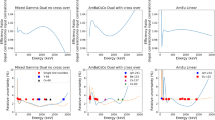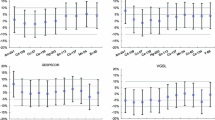Abstract
Coincidence counting in neutron activation analysis has well-known advantages, most importantly improvement of detection limits. One obstacle to the wider use of this technique is the complexity of the data acquisition and reduction systems that it requires. The usual approaches to multi-detector data acquisition incur significant dead-time, involve redundant work in repeatedly developing limited tools and risk potential errors in low-level code. The paper describes progress made in developing a software framework to address these shortcomings.


Similar content being viewed by others
Notes
Available on a public repository at github.com/usnistgov/qpx-gamma. For collaboration, please contact maintainer.
References
Vobecký M, Jakůbek J, Bustamante CG, Koníček J, Pluhař J, Pospíšil S, Rubáček L (1999) Multielement instrumental activation analysis based on gamma–gamma coincidence spectroscopy. Anal Chim Acta 386(1):181–189
Gardner RP, Mayo CW, El-Sayyed ES, Metwally WA, Zheng Y, Poezart M (2000) A feasibility study of a coincidence counting approach for PGNAA applications. Appl Radiat Isot 53(4–5):515–526
Metwally WA, Gardner RP, Mayo CW (2004) Elemental PGNAA analysis using gamma–gamma coincidence counting with the library least-squares approach. Nucl Instrum Methods Phys Res Sect B 213:394–399
Tomlin BE, Zeisler R, Lindstrom RM (2008) γγ-coincidence spectrometer for instrumental neutron-activation analysis. Nucl Instrum Methods Phys Res Sect A 589(2):243–249
Oshima M, Toh Y, Hatsukawa Y, Koizumi M, Kimura A, Haraga A, Ebihara M, Sushida K (2008) Multiple gamma-ray detection method and its application to nuclear chemistry. J Radioanal Nucl Chem 278(2):257–262
Toh Y, Oshima M, Kimura A, Koizumi M, Furutaka K, Hatsukawa Y, Goto J (2008) Reduction of Compton background from hydrogen in prompt gamma-ray analysis by multiple photon detection. J Radioanal Nucl Chem 278(3):685–689
Islam MEMA (2012) Characterization of multiple prompt gamma-ray analysis (MPGA) system at JAEA for elemental analysis of geological and cosmochemical samples. Appl Radiat Isot 70(8):1531–1535
Radford DC Radware software package. http://radware.phy.ornl.gov/
Lindstrom RM, Ammerlaan MJJ, Then SS (1996) Loss-free counting at IRI and NIST. J Trace Microprobe Tech 14(1):67–75
Burnett JL, Davies AV (2011) Development of a cosmic veto gamma-spectrometer. J Radioanal Nucl Chem 292(3):1007–1010
Matsumura H, Masumoto K, Toyoda A, Kinoshita N (2008) List-mode coincidence data analysis for highly selective and low background detection of gamma-nuclides in activated samples. J Radioanal Nucl Chem 278(3):733–738
Acknowledgments
This project was sponsored by the Material Measurement Laboratory, National Institute of Standards and Technology, Gaithersburg, USA. A note of gratitude for continued help and consultations to Richard M. Lindstrom and Rolf Zeisler at the National Institute of Standards and Technology, Gaithersburg, USA.
Disclaimer
Certain commercial equipment, instruments, or materials are identified in this report in order to specify the experimental procedure adequately. Such identification is not intended to imply recommendation or endorsement by the National Institute of Standards and Technology, nor is it intended to imply that the materials or equipment identified are necessarily the best available for the purpose.
Author information
Authors and Affiliations
Corresponding author
Rights and permissions
About this article
Cite this article
Shetty, M., Şahin, D. Data acquisition and analysis software for gamma coincidence spectrometry. J Radioanal Nucl Chem 309, 243–247 (2016). https://doi.org/10.1007/s10967-016-4762-0
Received:
Published:
Issue Date:
DOI: https://doi.org/10.1007/s10967-016-4762-0




